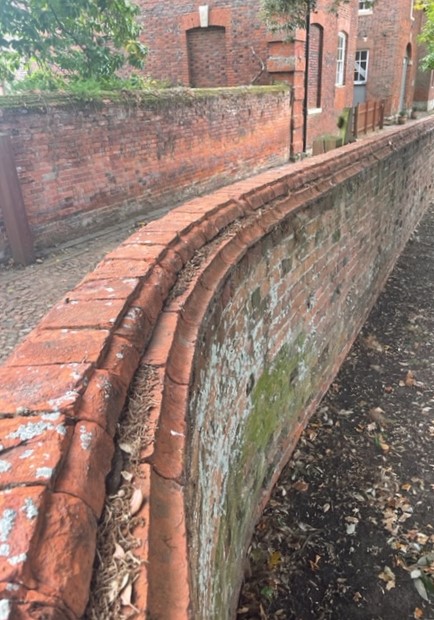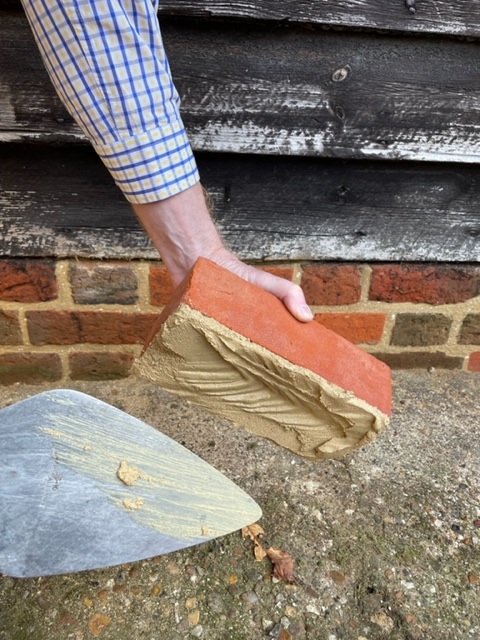Copings and Cappings
on Free-standing Brick Walls
Gerard Lynch
Free-standing brick walls have been used for centuries to demarcate boundaries, provide security, keep out noise and screen landscapes. Properly detailed and constructed, these have proved aesthetically pleasing and highly durable.
Traditionally they were no less than one-brick-thick, constructed to accepted craft practices and time-proven rule-of-thumb, largely using handmade bricks set in flexible lime-rich mortars. By modern standards they may appear over engineered but their mass and deadweight created stability and resistance to lateral forces, particularly from high winds. This changed after the second world war with economy of materials and the move to thin-walled construction largely using machine-made bricks set in hard and rigid cement-based mortars, typically up to 1.8m (six feet) high. Neither properly designed nor covered by statutory control, these cheap garden walls sprang-up across the country on new housing estates. Most soon exhibited deterioration and some blew over, particularly where built on plastic DPCs which were unsuited to such construction and acted as a hinge.
EXPOSURE
Unlike the outside walls of a building, free-standing walls are invariably subject to exposure from the elements on both faces and from above, making them vulnerable to saturation, which is often the main cause of deterioration. The ingress of moisture is particularly severe during the months of late autumn and winter when they are exposed to long spells of wind-driven rain and from melting snow on wall heads. Once saturated, masonry is vulnerable to the potentially damaging effects of freeze/thaw cycles. Although local knowledge of typical weather patterns is important, reference should also be made to exposure maps of the UK that illustrate zones of differing exposure to wind-driven rain when specifying repairs.
Most historic bricks were made from topmost clays and, by modern standards, were low-fired. Yet these have proved durable, regardless of strength, because these have an interconnected, open-pored structure that can accommodate and dissipate the hydrostatic pressure arising from an eight per cent expansion of frozen water. The open-pored structure also helps bricks to dry out more quickly once dry weather returns. Many modern bricks, no matter how hard, have porestructures that cannot accommodate this, resulting in spalled faces.
It is well known that the air lime or hydraulic lime binders of the mortar joints on traditionally constructed brickwork act as the conduit through which the wall ‘breathes’, allowing moisture that has saturated the masonry to then rapidly dry-out. So, the wall is said to behave with an ‘overcoat effect’ (as opposed to a raincoat effect which sheds water). Such relatively low-strength mortars also act as a flexible gasket that, having the same coefficient of expansion as clay bricks, can accommodate thermal changes without the need for movement joints. On the other hand, the strong, rigid and impermeable modern OPC-based mortars are intended to act more as a gap-filling glue and are generally used to bind more highly-fired bricks. As a result the surface of the brickwork sheds rainwater like a raincoat and, being relatively rigid, these walls require movement joints to accommodate the cumulative stresses induced.
WORKMANSHIP
Of critical importance in the construction and repair of a traditional free-standing wall is that all bricks must be laid frog uppermost upon full beds of lime mortar, not deeply furrowed, and all cross joints fully filled. The bad craft practice of tip-jointing just the brick edges must be prohibited. Filling all joints in this way will aid overall strength, help to minimise the ingress of destructive water into the core of the wall, and will eliminate potential water reservoirs so the wall dries-out faster.
Where old walls are deemed in need of some localised repairs and/or re-pointing, it is important to identify the original mortar so that a compatible lime-based mortar can be prepared. Generally, the new mortar would be expected to have the same ratio of aggregate to lime, and the aggregate should match the original as closely as possible. Look out for particles of old brick or stone in the mix which may have been included to help enhance the mortar. The finish of the joints should also match the immediately surrounding areas or, if obvious, the original profile.
TREATMENT OF THE HEADS
Of primary importance to the long-term stability of all free-standing brick walls is that the tops, or heads, must always be provided with well-detailed protection in the form of copings or cappings, which are laid in a suitably specified lime-based mortar and jointed flush to avoid hollows:
Copings are defined as having a good overhang on either side of the wall – typically 40mm or 11/2 inches – with a throat to catch and shed water run-off clear of the brickwork directly below
Cappings are usually flush to the width of the wall: but if they do have an overhang this will not have a throat.
The functions of copings and cappings are both protective and aesthetic and should follow four main points:
- Having a slope, for weathering, on the top to shed rainwater quickly
- Keeping water run-off away from the wall face as much as possible
- The material used should be durable and resistant to weather action
- They should contribute positively to the aesthetics of the wall and the vernacular details of the area.
TYPES OF COPINGS AND CAPPINGS
Since the late 19th century cementitious materials such as artificial stone and concrete have been used for copings and cappings, often replacing earlier materials such as natural stones, terracotta or brick. These earlier materials vary both regionally according to what was available locally as can be seen in the illustration above. Also as one moves from one period to the next these choices reflect changing architectural styles, materials and craft practices. For example, stone copings reflecting the local geology can be found on Stuart, Georgian and Victorian brick walls in areas with good building stone where brick was a late arrival, particularly where the local stone could be easily split into flags and coping stones. In areas where the locally available stone was poor, brick and terracotta copings and cappings are likely to be most common. Both plain and ornamental terracotta designs were popular, although standard bricks laid in a variety of configurations, and particularly specially shaped bricks, purpose-moulded to shed water, were very highly favoured.
As all copings and cappings will suffer periods of saturation, in former times suitable locally-made bricks were selected by empirical knowledge and pragmatic experience, to minimise the risk of frost action and, in some cases, the liberation of soluble salts too. Today, local knowledge and experience is supplemented by selecting clay bricks known to be suitable for designated exposure levels ranging from ‘sheltered’ or ‘moderate’ exposure to ‘severe’ or ‘very severe’, according to which part of the country you are working in. Modern bricks must satisfy declared frost-resistance ratings of F2 (which is the highest of three categories – F0 being non-frost-resistant and F1 being moderately resistant), and a declared soluble salt content designated of S2 (the category with the lowest active soluble salt content). Although it is important to complement the original brickwork, generally brick copings and cappings should be dense, preferably with a smooth finish to repel the water, or engineering bricks should be used.
Copings and cappings come in three basic shapes:
- Saddle-back or ‘twice-weathered’
- Feather-edged, ‘splayed’
or ‘once-weathered’ - Half-round – or ‘segmental’.
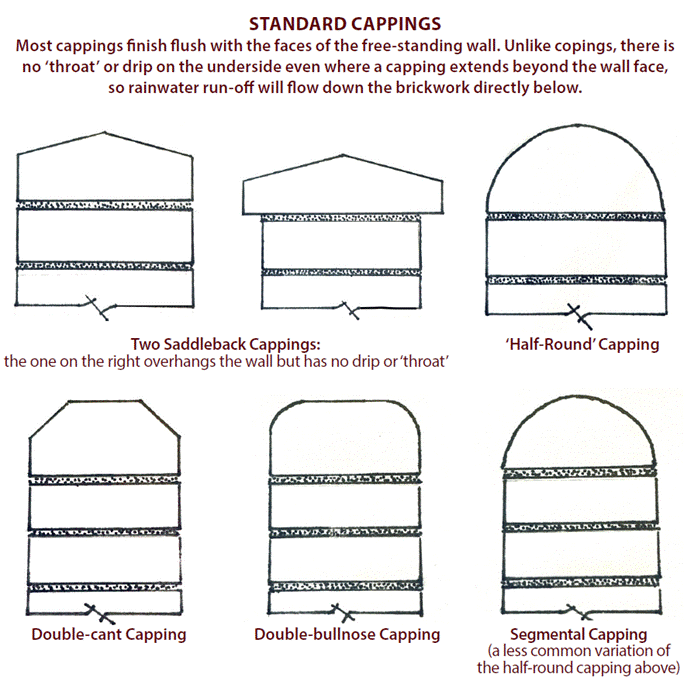
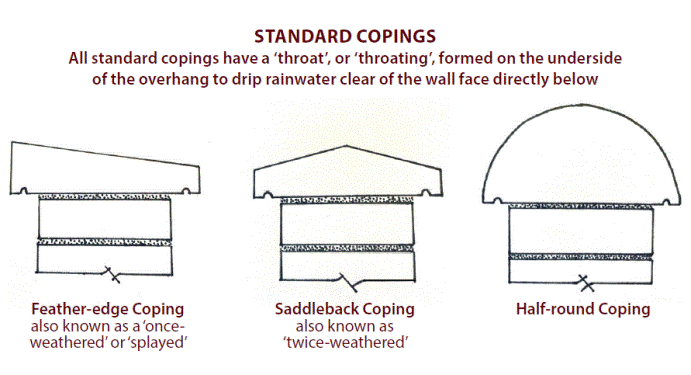
(Diagram: Gerard Lynch)
STONE COPINGS AND CAPPINGS
Traditionally, stone copings and cappings were fully bedded in a lime-rich mortar applied straight onto the topmost course of bricks, but modern codes of practice deem that they should be bedded on a specified type of flexible DPC, such as high-bond bitumen polymer, to prevent moisture movement seeping down into the brickwork below through micro cracks that might develop within the connecting cross joints. Polyethylene DPCs are prohibited because they will not bond with the mortar leading to displacement of the masonry above. Nonetheless, where any DPC is used it is essential to prevent a slip-plane by sandwiching the full width of the DPC between two beds of mortar, and by immediately bedding copings or cappings onto it to gain maximum suction and bond strength. Adding weight on top will also help with adhesion.
All connecting cross joints should be fully- and tightly-jointed to ensure solidity and to minimise the possibility of cracking: and the joints should be finished flush.
For extra security the copings or cappings are sometimes fixed together with non-ferrous cramps set into appropriately sized pre-cut slots in the top, particularly on sloping sections of walling.
BRICK COPINGS AND CAPPINGS
Historically, clay bricks have been used very successfully for copings and cappings on free-standing walls. Frequently these were the local brickmaker’s special-shaped bricks, often bespoke-made and oversized to suit the designer’s requirements. The advent of a nationwide network of canals and then railways saw the introduction of more robust bricks for this purpose across the UK, like the famous ’Staffordshire blue’ engineering brick. Transport improvements also saw stronger classes of building limes becoming more widely available too.
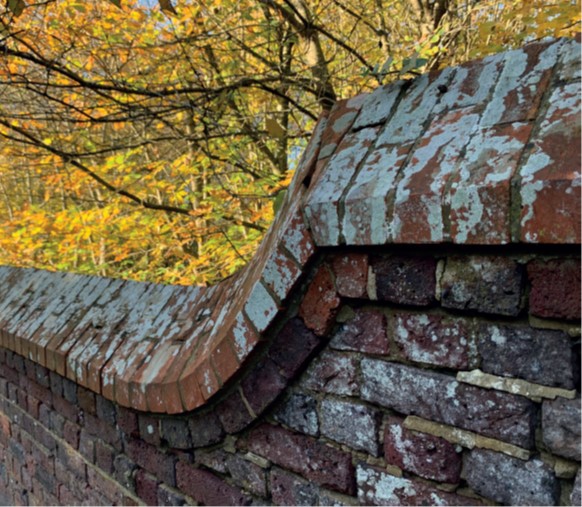 |
||
| A particularly fine example of the use of standard bricks to make a saddleback capping (Photo: Nicholas Taylor) |
COPINGS AND CAPPINGS MADE FROM
STANDARD BRICKS
The artistic skill of traditional bricklayers is sometimes seen on the finish to thick-walled construction through the careful manipulation of standard bricks, set to bond at 45⁰, to form an attractive saddle-back coping; the stopped-ends of which demand great accuracy and skill to measure, cut and set to terminate the brickwork correctly. In later years a more basic brick-on-edge became popular, comprising evenly-sized bricks set to gauge, laid with fully-filled joints, termed ‘buttered’ within the craft, when applied from the trowel onto the brick held in the other hand – preferably set with a slight tilt across them and jointed flush, to shed water. In some areas of the country this was improved by bedding the bricks on two half-bonded courses of flat clay tiles known as ‘creasing tiles’ which were bedded with thin joints to overhang the wall face. The tops of the creasing tiles were finished with a sloped mortar fillet to shed water.
COPINGS AND CAPPINGS MADE FROM
SPECIAL-SHAPED BRICKS
The use of certain purpose-made, special-shaped, clay bricks, of standard size or longer, for both copings and cappings has a long and very successful history. Where standard special-shaped bricks such as the double-bullnose, double-cants and half-round cappings are used, and providing they are evenly sized, laid with fully filled mortar joints that are finished flush, they can look pleasing. However, these do not shed rainwater clear of the face below. For new walls a better arrangement therefore, is to either detail these with an overhanging tile creasing or plinth bricks, or use saddleback and half-round copings, with a throat on the underside of the overhang. Again, though historically these were not laid on a DPC this is no longer deemed best practice by the Brick Development Association and reference should be made to it and the relevant Codes of Practice for all new work.
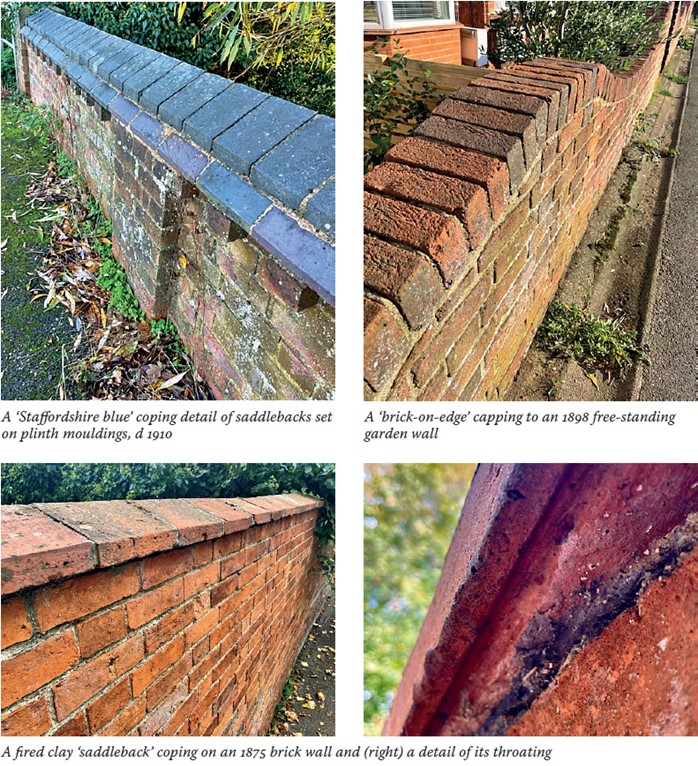

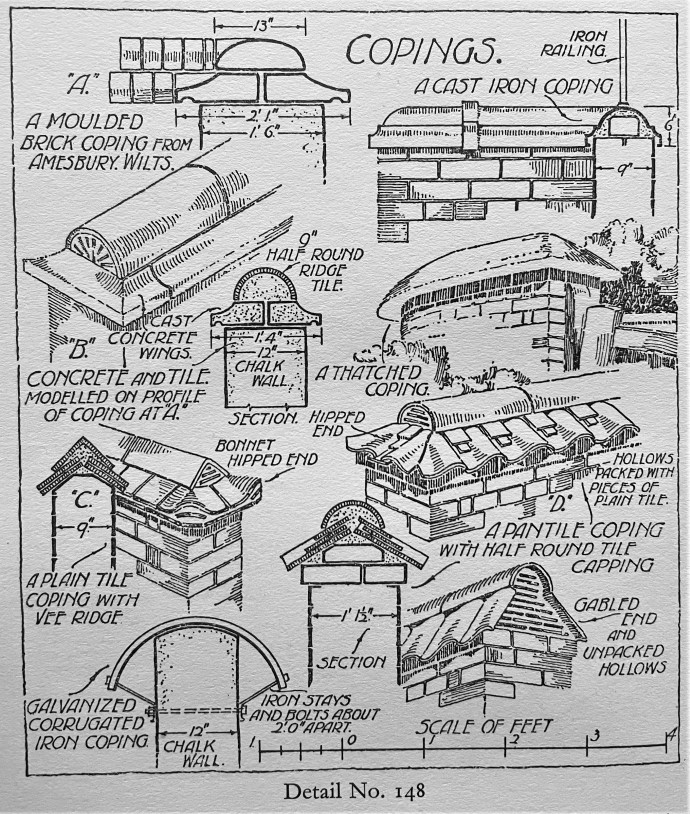
Copings in various materials shown in Brickwork and it’s Construction by Walter R Jaggard
(Oxford University Press, London, 1931)
Recommended Reading
RW Brunskill, Brick Building In Britain, Victor Gollancz Ltd, London, 1990 Historic England, Practical Building Conservation, Earth, Brick and Terracotta, Ashgate 2015
M Jenkins, Traditional Scottish Brickwork, Historic Environment Scotland, 2014
G Lynch, ‘Tudor Brickwork’, The Building Conservation Directory, Cathedral Communications, 2012
G Lynch, ‘Joint Finishes on Historic Brickwork’, The Building Conservation Directory, Cathedral Communications, 2016
G Lynch, ‘Hot-mixed lime mortars and traditionally constructed brickwork’, The Journal of The Building Limes Forum, 2017
G Lynch, Brickwork History, Technology and Practice, Rutledge, 1994
G Lynch, The History of Gauged Brickwork, Elsevier, 2007
N Lloyd, A History of English Brickwork, H Greville Montgomery, London, 1925



